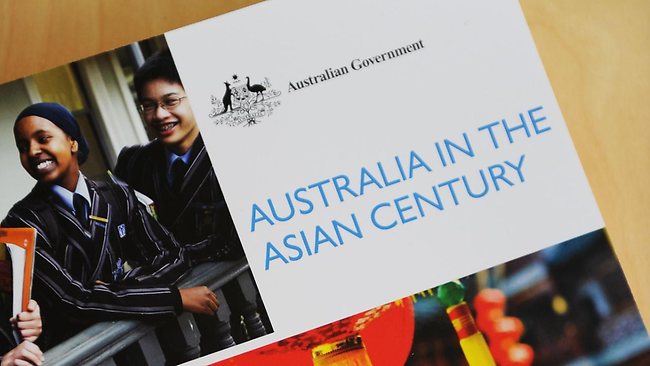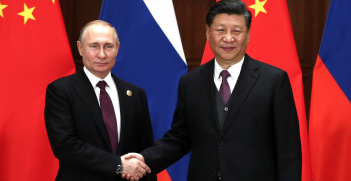Australia in Asia: From Engagement to Integration

The transformation of Asia this century is comparable to what occurred in Japan during the extraordinary periods of growth in the 1950s and 1960s. Only this time it isn’t just happening in one country, it’s happening across an entire region, and its pace and scale is truly staggering. If Australians want to make the most of the Asian century, we can’t think of ourselves as standing apart from Asia, selling products and services into it. Rather, we will be most successful through deep and seamless integration with our neighbours.
Today, around 40 per cent of global economic activity is occurring in Asia and world growth continues to be led by Asia, despite recent slowing in China.
If we consider how far the Asian giants of China and India have come, and how much further they will have to travel in order to attain developed world income levels, it would be reasonable to conclude that the shocks we have experienced to date will, in due course, be seen as relatively small. Perhaps these countries will never reach developed world status. But it would be foolish to base our strategic thinking on that assumption.
This is what motivated the development, a few years ago, of the white paper, Australia in the Asian Century. I won’t repeat its findings. Instead, I will offer some remarks about three matters that featured strongly then but which appear to confound policy making today:
- supporting the development of Asia‐relevant capabilities;
- developing a rational, consistent attitude to foreign direct investment, especially from China; and
- understanding Australia’s particular sources of international competitiveness in the Asian century.
Asia‐relevant capabilities
In leading the extensive consultations that contributed to the development to the white paper, I often heard the need for Australians to possess what we labelled “Asia‐relevant capabilities”. Things like understanding the way business is done in Asian countries, having the appropriate cultural understanding to operate in different nations and, not least, for a smaller set of people, the language skills that enable us to negotiate and develop personal relationships in languages other than English.
In the years since the white paper was launched, I have become even more convinced that securing prosperity in the Asian century demands an intense focus, by policy makers and business, on an important set of Australian capabilities.
Foreign direct investment
I wonder how many of the people presently agitated about emergent Chinese foreign investment in Australia are aware that the Foreign Investment Review Board was established in the mid‐1970s as a result of concerns about investment from the United States. How many would be aware that, even today, the United States remains our largest foreign investor, with the US and the UK, together, accounting for nearly half of the stock of foreign investments in Australia? How many would be aware that China, by contrast, accounts for less than 2.5 per cent?
Our reliance on foreign direct investment has a straightforward explanation. Australia has a high rate of investment; that is, investment in physical capital relative to output. But our national saving rate (national saving as a proportion of output) has not been high enough to finance all of our investment. Thus, we are a current account deficit country, reliant upon funding from offshore.
That funding will generally come from countries unable to offer equally attractive investment opportunities; countries in which national saving exceeds national investment. Some of the funding will enter Australia as debt, some as portfolio equity and some as foreign direct investment.
Historically, foreign direct investment has supported a relatively high rate of economic growth, created employment opportunities, improved consumer choice and, in some cases, promoted healthy domestic competition.
Sources of competitiveness
In the development of the white paper, I heard many times that many of the skills and qualities Australians bring to the table are valued highly by our regional neighbours. Our creativity, independence and initiative are just some of the skills and qualities that are valued.
In the early 1990s, as Australian tariffs were being cut and the Asian Tigers were developing rapidly, it was common to hear Australian business people say that their international competitiveness was being damaged by the costs to business of a set of Australian attributes developed over generations: a preoccupation with governance, incorruptibility and respect for the rule of law; the separation of powers; safe working conditions; and institutions that support social harmony, economic and social opportunity, and tolerance.
Today, every one of these attributes constitutes a potential source of competitive advantage, not disadvantage.
Ultimately, our international ‘competitiveness’ and the pattern of our economic integration with the Asian region, will be determined by our particular set of national endowments, natural and created.
Our natural assets include things like clean water, an abundance of mineral and energy resources, healthy ecosystems and productive soils. All of these are at risk because of unsustainable practices. That has to change; our future depends on it.
Our people constitute a further source of competitive advantage. In 2015, the ABS estimated that 28.2 per cent of the population (6.7 million people) were born overseas, an increase of nearly two million people compared to 2005.
In the past few years, there has been a significant shift in the source countries from which people are migrating permanently to Australia. Just a few years ago, China overtook the United Kingdom as the principal source country. The very next year, India took top place surpassing both China and the United Kingdom. Migrants from Asia don’t just bring cultural and social diversity to Australia; though they certainly do that. Their knowledge of Asia, cultural and historical understanding, and language skills, also provide valuable skills for employers to harness in the Asian century.
And it is important also to understand the contribution to international competitiveness that has been made by foundational investments over several generations in strong legal and government institutions; public infrastructure such as our schools and hospitals; and the universities and business that support innovation and research.
Towards a better place
I have written of the need to bridge the gap between where we are now, bogged in the dysfunctional politics of fear and blame-shifting, and the place we should aspire to be. That would have Australia as the ideal place to do business, providing access to labour with the right skills, and to deep and liquid capital markets that are sophisticated and robust. This vision has to be part of the contemporary narrative.
Here is another bit of the narrative: If we want to make the most of the Asian century, we can’t think of ourselves as standing apart from Asia, selling product and services into it. Rather, Australia will be most successful through deep and seamless integration with our neighbours.
And here’s a third bit of the narrative. It is the most important. It concerns the need to focus on building capability in all citizens, so that all Australians have the opportunity to choose a life of value. This set of capabilities includes political voice; freedom from bigotry; a well-resourced and respected public service; an accessible judicial system; independent, apolitical media; education systems that attract students to pathways to knowledge; affordable heath services and housing; programs that support structural adjustment; and science and innovation systems that support creativity and the commercialisation of ideas. And right now, it means also building in all Australians a set of Asia‐relevant capabilities.
I want to emphasise that this focus on individual capability building is not a footnote to the narrative. It must be at its core.
In the 1980s we developed a highly successful Australian model of globalisation. It matched the removal of external barriers to trade and investment with domestic policy discipline and a determination to build capability in those who might otherwise have been disadvantaged by free markets.
This model has not been lost. But we do seem to have forgotten how to use it.
Dr Ken Henry AC FASSA FAIIA was Secretary to the Treasury and a member of the board of the Reserve Bank of Australia between 2001 and 2011. As special adviser to Prime Minister Gillard in 2011 and 2012, Dr Henry was responsible for leading the development of the white paper on Australia in the Asian Century. He is chair of National Australia Bank and the Sir Roland Wilson Foundation at the ANU. In February 2016 he was made a Fellow of the Australian Institute of International Affairs.





